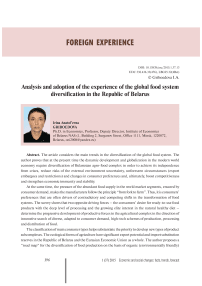Analysis and adoption of the experience of the global food system diversification in the Republic of Belarus
Автор: Griboedova Irina Anatolevna
Журнал: Economic and Social Changes: Facts, Trends, Forecast @volnc-esc-en
Рубрика: Foreign experience
Статья в выпуске: 1 (37) т.8, 2015 года.
Бесплатный доступ
The article considers the main trends in the diversification of the global food system. The author proves that at the present time the dynamic development and globalization in the modern world economy require diversification of Belarusian agro-food complex in order to achieve its independence from crises, reduce risks of the external environment uncertainty, unforeseen circumstances (export embargoes and restrictions) and changes in consumer preferences and, ultimately, boost competitiveness and strengthen economic immunity and stability. At the same time, the pressure of the abundant food supply in the world market segments, ensured by consumer demand, makes the manufacturers follow the principle “from fork to farm”. Thus, it is consumers’ preferences that are often drivers of contradictory and competing shifts in the transformation of food systems. The survey shows that two opposite driving forces - the consumers’ desire for ready-to-use food products with the deep level of processing and the growing elite interest in the natural healthy diet - determine the progressive development of productive forces in the agricultural complex in the direction of innovative search of diverse, adapted to consumer demand, high-tech schemes of production, processing and distribution of food...
Diversification, food system, consumer demand, food
Короткий адрес: https://sciup.org/147223692
IDR: 147223692 | УДК: 338.436.33(476) | DOI: 10.15838/esc/2015.1.37.13
Текст научной статьи Analysis and adoption of the experience of the global food system diversification in the Republic of Belarus
The dynamic development and globalization in the modern world economy require diversification of the national agrofood system in order to achieve its independence from crises, reduce risks of the external environment uncertainty, unforeseen circumstances (export embargoes and restrictions) and changes in consumer preferences and, ultimately, boost competitiveness and strengthen economic immunity and stability of the Belarusian agro-food complex. The above circumstances substantiate the goal of the conducted work , which is to study the evolution and identify megatrends in the diversification of the global food system for the scientific justification of new principles and directions of best practices adoption in the Republic of Belarus.
Food export is an essential element of agricultural policy of the Republic of Belarus; assessing the foreign economic activity of the country’s agricultural complex in terms of food supplies according to the global market requirements we can note that the work results have exceeded the limit of 5 billion U.S. dollars export revenues, with the trade surplus in this group of goods.
According to rational norms of consumption of own population, the Belarusian food reserves can satisfy the annual demand of more than 60% of the population of Moscow in meat products, almost 80% – in dairy products and can meet the needs of the Russian capital residents sure for a year and a half.
Nowadays, however, the range of the most significant manufactured and exported food products are limited. The analysis of the data provided by Food and Agriculture Organization of the United Nations (FAO) indicates that the production of milk, beef and pork has accounted for 65% of the monetary value of agricultural production in Belarus. Of the 20 leading export positions 95% accounts for meat and dairy and refined sugar (82% and 13%, respectively). Due to the threatening dominance of low-margin dairy products, fresh chilled or frozen meat (carcasses, half-carcasses and cuts) that amount to 59.5% of the export, it is concentrated in the product areas that do not provide access to the global markets characterized by a high added value of the products [14].
Therefore, the search and adoption of promising directions of agroindustrial complex development are critical for boosting the competitiveness of the Belarusian economy in general.
Forming the information society, information becomes a separate element of the productive forces and its impact on economic decisions and the creation of innovative management algorithms is one of the strategic factors of effective progressive development.
Thus, the analysis of the main directions of global food market diversification is relevant and very important.
The population needs are sources and drivers of the development of the agrofood industry as the economy sector aimed at final consumption of the society. The change in these requirements presupposes the appearance of new forms of labor social division that boost material production through the development of productive forces. New types of labor are created.
During the previous millennia the way of food production was distinguished by the significant degree of conservatism: food was traditionally produced, sold and consumed at the local scale (in fact – within “walking” distance). Today, despite the fact that there are still local markets for the products produced in the traditional way, only for the last few decades the overall picture of food production and consumption has drastically changed in favor of a large variety of the so-called “international” products. This is particularly noticeable in the developed countries, where the society has raised food availability through industrial production, as well as regional and international food trade. Nowadays food and health, safety, stability, comfort, individualism, healthy ageing and authenticity, etc. want the national food systems to be flexible.
The transformation process has covered the global food market, and the subsequent changes are having an increasing impact on the stages of production, processing, packing, distribution, exchange and consumption of food, i.e. on all stages of the food chain.
Since the modern agricultural production is one of the most complex of production and economic systems, the binder in the whole economic activities of the so-called cycle “from farm to fork”, then presents a comprehensive picture of the evolution of the world food system as the quintessence of scientific works of domestic and foreign scientists, and practices relevant research institutions dealing with problems of the functioning of the individual stages of the food chain.
Food consumption . Although consumption is a final stage in the food system, the pressure of the abundant food supply in the world market segments, ensured by solvent consumer demand, makes the manufacturers follow the principle “from fork to farm”. Thus, it is consumers’ preferences that are often drivers of contradictory and competing shifts in the transformation of food systems.
-
1. The changes in the balance of food consumed. For example, according to FAO, the developed countries are decreasing the consumption of potatoes, milk and red meat, at the same time, increasing the consumption of fruit, vegetables, pork, poultry, fish and seafood. It influences the world production of the most important food commodities and agricultural raw materials ( fig. 1 ).
-
2. The increase in the living standard, change in the lifestyle and demographic situation, growth in the number of working hours among employed population and the share of employed women, availability of the variety of refrigeration equipment for households, etc. These factors cause a decrease in the demand for fresh products and a simultaneous increase in the demand for semi-manufactured, processed (frozen or chilled) and ready-to-eat products; the preference of the advertised diet with the qualities more associated with marketing, cinema, TV, culture stars than the special nutritional properties; an increase in “snacking”, leading to the expansion of the
types of feeding points, especially points of impulse purchases (service stations and vending machines appear in addition to small food shops and stalls); and finally, eating out accounts for a significant share of consumption (Michaelis and Lorek, 2004). As a result, the culinary products category, including ready-to-use food products and basic culinary products, consistently holds a leading position in the monetary value of world food trade ( fig. 2 ).
-
3. The increased awareness of risks along with the social concerns associated with consumption (body weight, energy balance disorder, eating out of habit, unbalanced diet); the attention paid to the environment and
Figure 2. Top 10 most important export commodities of the world, 2011
At the same time, the rapidly developing countries are characterized by the change of the predominant share of grain crops to diary (India) and meat (China) products. According to the forecasts (Steinfeld and others, 2006), the global demand for foods of animal origin in 2000–2050 is expected to double [13].
Figure 1. Dynamics of the world production of the most important food commodities and agricultural raw materials, 2011 to 1994 in %
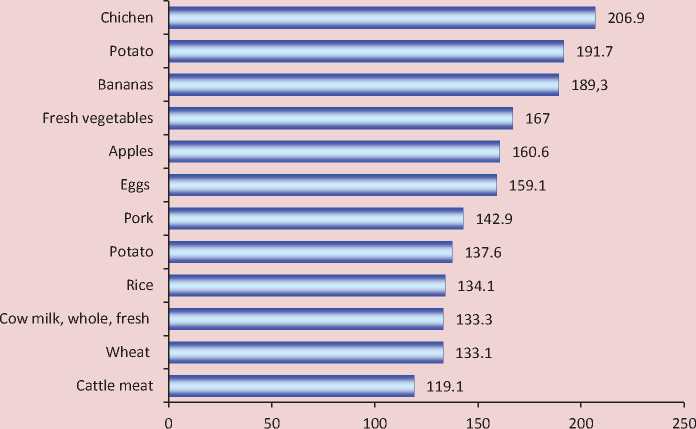
Note. Compiled with the use of the FAOSTAT data [14].
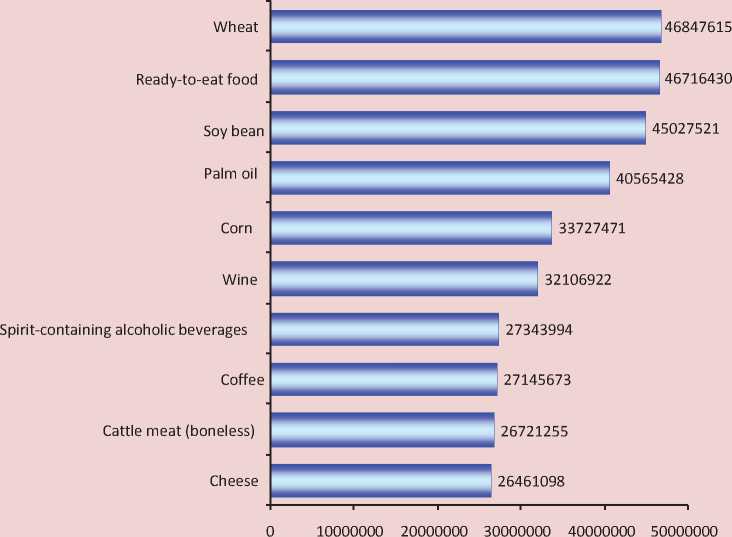
-
Note. Compiled by the FAOSTAT data [14].
ethics issues (including animal protection, working conditions, child labor, conditions of trade). This involves the development of a diametrically opposite trend – the growing interest in healthy eating, the increasing demand for organic, vegetarian products, products without artificial additives, as well as products purchased in accordance with the fair trade principles [5; 6; 10]. According to the International Federation of Organic Agriculture Movements, 162 countries around the world are actively involved in organic agriculture along with traditional agriculture, and the volume of certified organic products is annually growing by 20–30% ( tab. 1 ).
Nowadays, in this segment of the global food market supply is lagging behind rapidly growing demand; and according to the international experts, the global market for organic products in 2020 will amount to 200–250 billion U.S. dollars.
In accordance with the considered socio-economic trends we suggest the following basic segmentation of key consumer types, which satisfaction should be aimed at the activity of the agro-food complex:
– a consumer who cares about health, prefers fresh products to maintain a healthy lifestyle: for example, low-fat food that is low in fat and rich in vitamins and minerals;
Table 1. World organic production: key indicators and leading countries
|
Indicator |
Value |
Country-leaders |
|
Organic products market volume |
2011: 62.9 billion U.S. dollars 2000: 15.2 billion U.S. dollars |
2011: USA: 29 billion U.S. dollars Germany: 6.6 billion euros France: 3.7 billion euros |
|
Countries, certified for organic agriculture |
2011: 162 countries 2000: 86 countries |
|
|
Organic agricultural land |
2011: 37.2 million hectares 1999: 11 million hectares |
Australia: 12 million hectares (2009) Argentina: 3.8 million hectares USA: 1.9 million hectares (2008) |
|
Note. Compiled by the data [11]. |
||
– a consumers who cares about the environment, prefers raw (fresh) products or products with short supply chains, products of organic agriculture;
– a consumer who loves nature and animals, is interested in methods of primary production, concerned about genetic modification, considers animal protection an important issue, focuses on ethical efficiency of production systems;
– a consumer who appreciates convenience, prefers snacks, fast food .... take-away, ready-to-eat food, easy-to-prepare food, restaurant food;
– a consumer who focuses on the optimal ratio of price and quality (for example, products of mass production, cheap semi-finished products);
– a consumer-hedonist who prefers exotic specialties, delicacies, products with value-added, food as entertainment and leisure, restaurant food, high organoleptic quality food;
– a consumer who looks for variety and likes the variety of semi-finished products, components and finished products for home cooking and the variety of types of food (from carefully prepared gourmet homemade food to a good somewhere else) [11; 12].
Of course, none of the consumers follows the pattern absolutely, for example, on weekdays convenience can prevail, while at the weekend – interest in gourmet food or care about a healthy lifestyle. At the same time, this classification helps define key areas of demand diversification and new promising types of work in the sphere of domestic production of food raw materials and finished food products.
The development of productive forces and the resulting changes in the specific structure of food products is advisable to consider in accordance with the stages of the food chain. Let us consider the main stages of the agro-technological evolution in historical retrospect ( fig. 3 ).
Production of food raw materials and primary food products . Natural fertilizers (substances of organic origin) were already used in ancient China, and recommendations for their use were reflected in the work of Cato “On agriculture” (Rome, 2nd century BC).
However, for thousands of years this area had been characterized by the sufficient degree of technological conservatism – before the use of chemical fertilizers in the 19th century [5]. As for the permanent
Figure 3. Historical retrospective of the main stages of agrotechnological evolution
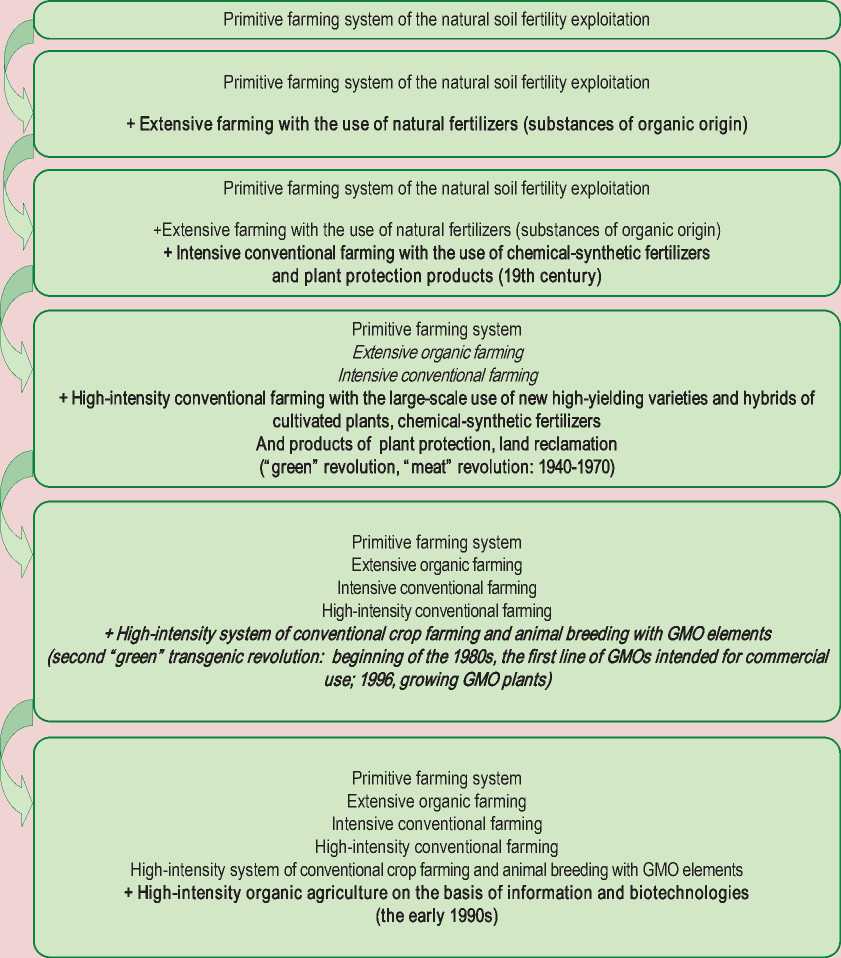
process of agro-technological shifts (agrochemical, transgenic, information), it entered the most active phase in 1940– 1970 (fig. 4) and since the beginning of “green revolution” it has been developing in the form of integrated management results in the chain of systemic factors of agricultural production (new plant varieties and animal breeds – nutrients – protection from pests and diseases – harvest) [1].
Figure 4. Total area of genetically modified crops in different countries of the world, 2013, million hectares
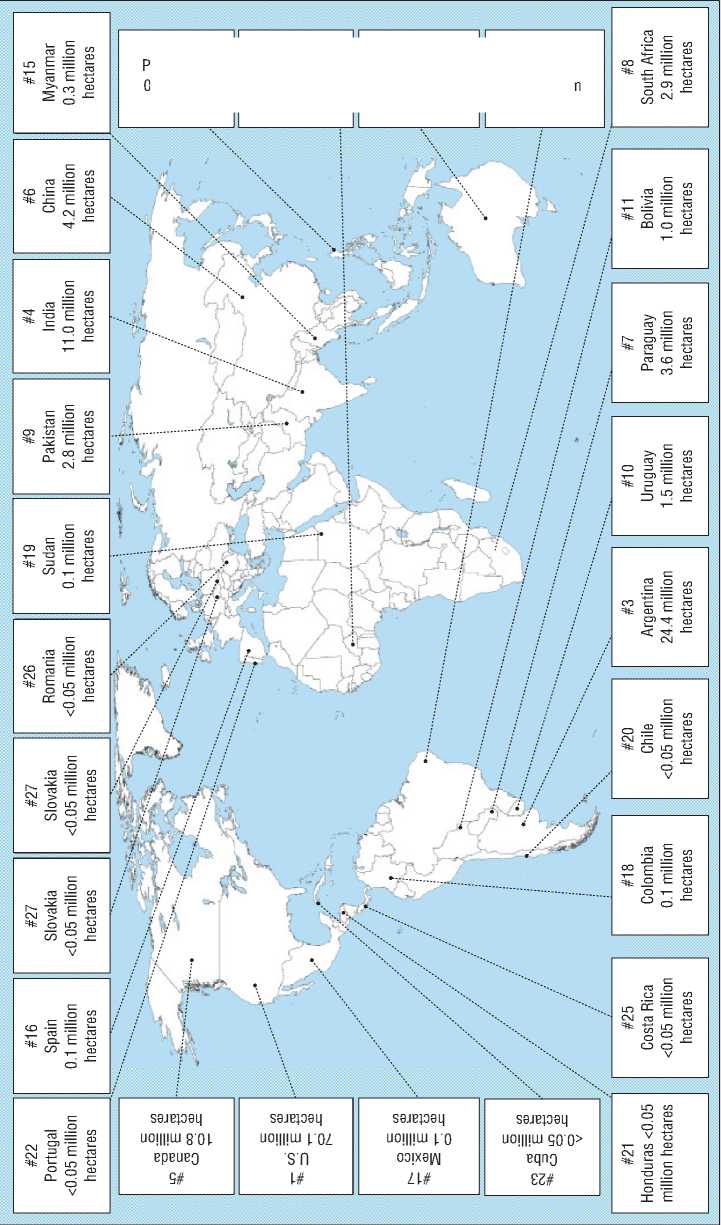
Note. Compiled by [9].
|
#12 |
#14 |
#13 |
#2 |
|
Philippines |
Burkina Faso |
Australia |
Brazil |
|
0.8 million |
0.5 million |
0.6 million |
40.3 million |
|
hectares |
hectares |
hectares |
hectares |
On the one hand, the development of productive forces by means of high technology has determined a sharp leap in the efficiency of traditional (conventional) agricultural production by increasing the productivity of agricultural plants.
The increased production of wheat, rice and maize and the proportional reduction in prices have not only caused an increase in their direct consumption, but also expansion of forage reserves and rise in livestock productivity (trend called as “meat revolution”).
Today according to the leading Belarusian-Russian scientist in the field of postindustrial development V. Inozemtsev, “the post-industrial world enters the 21st century as a quite autonomous social formation that monitors the world production of technology and sophisticated high-tech products, it provides itself with industrial and agricultural products, is relatively independent of supplies of energy and raw materials” [3].
It is intellect-generated knowledge and its embodiment at the level of productive forces development that allows the postindustrial world leaders to go far beyond the productivity growth in agriculture and the scope of self-sufficiency with regard to the agrarian sector.
The implementation of the National Export Initiative (NEI) of the U.S. Administration has led to the 4 billion U.S. dollar increase in food and agricultural commodities export by 2012. It is a record figure that amounts to 145 billion U.S. dollars. USA ranks the 1st in the world ranking of the top ten exporters of wheat first ( tab. 2 ).
In this group of leaders the well-developed economies of France and Germany hold a strong position; for example, in France grain crop productivity is twentyfold and labor productivity per person employed in agriculture hundredfold higher than in Botswana (3.6 centner per hectare and 762 U.S. dollars, respectively).
Table 2. Indicators of agricultural activities in some countries
|
Country |
Share of the employed in agriculture in the total employment, 2009–2012, % |
Value added per employee in agriculture, 2009–2012, U.S. dollars |
Wheat export, 2012, tons |
Monetary value of wheat export, 2012, thousand U.S. dollars |
Grain yield, 2012, kg/ha |
|
USA |
2 |
49817 |
32789893 |
11134659 |
59 |
|
France |
3 |
76586 |
20345934 |
6738299 |
75 |
|
Australia |
3 |
53777 |
17657181 |
5709036 |
22 |
|
Canada |
N/a |
59818 |
16335086 |
5742111 |
35 |
|
Russia |
10 |
5969 |
15185953 |
3671176 |
19 |
|
Argentina |
1 |
N/a |
8411136 |
2508660 |
48 |
|
Germany |
2 |
32087 |
6168890 |
1981035 |
69 |
|
Ukraine |
17 |
4375 |
4097309 |
1070292 |
32 |
|
Kazakhstan |
26 |
3533 |
2891482 |
609419 |
10 |
|
Brazil |
15 |
5035 |
2350720 |
699110 |
46 |
|
Note. Compiled by the World Bank data [4]. |
|||||
On the other hand, intensification of the avalanche-type and often uncontrolled use of chemical-synthetic fertilizers and means of protection, concentration of animal breeding in the industrial-type complexes, increased waste produced by the food industry, unpredictability of the GMO-organisms’ impact on the environment and animals and genetically modified food on humans have caused public concerns about degradation of the environment and people’s health [8].
The historical retrospective shows that since the early 1990s the process of the integration of intensive industrial and biological methods and the ecologization of agricultural production due to the growth of knowledge-intensive high-performance organic agricultural technology has been developing, in particular, by means of replacing the chemical synthetic agents by environmentally friendly biological products (see fig. 4). Thus, diversification in the production of food raw materials and primary food products has mainly affected the development of agricultural technology.
At the same time, despite the fact that the composition of the main species (enlarged groups) of agriculture products has not undergone significant changes, the development of breeding and genetic methods (selection for heterosis based on the use of inbreeding and outbreeding, creation of directed mutations methods, etc.) has contributed to the emergence of new varieties of agricultural crops (including well-known cross-breeds and hybrids of fruits and vegetables obtained due to interspecific crosses of plants: nectarine, tangerine, neshi, pluot, broccolini, yuzu, jostaberry, etc.), as well as to new forms of animals – breeds, types, lines, crosses with new desired properties (mule is the most famous example of the heterosis use for practical purposes; it is a cross of horse (Equus caballus) with donkey (Equus asinus) [2].
Processing of food raw materials and primary food products . Nowadays the developed countries produce food mainly industrially: about 80–90% of food raw materials undergo some degree of processing; the scientific approaches are replaced by traditional methods (although still there are traditional roots of many processes) to address the following problems in food production:
– best possible use of raw materials so that food ingredients and finished products can meet the consumers’ requirements for high quality;
– efficient use of water and energy resources, packing and other materials (processing aids, etc.) required for processing;
– processing methods that are reliable and meet the consumers’ perception, social and cultural values;
– economic performance of sustainable recycling schemes.
In the sphere of processing the principle “from fork to farm” is applied in “reverse engineering” and at the present time new system approaches to food industry engineering systems are developing. The areas of interdisciplinary research are based on the study of genetic, physiological, psychological and behavioral factors, knowledge and concepts borrowed from physics, chemistry, mathematics and informatics.
For example, innovative solutions are used in high technology molecular gastronomy – a direction that represents cooking as a symbiosis of chemical and physical processes. The key phrases to describe the requirements to the modern refining process are the following: “just in time”, “in the right place”, “in accordance with the requirements”, “for a specific person”, “in accordance with the principle of sustainability”. The challenge is how to produce meals that are rich in fiber and minerals, low in salt and “bad fats”, do not have allergens, but have high organoleptic parameters and value for money that satisfies the consumer’s needs. This requires a number of studies aimed at diversifying production technology and a range of foodstuff in the direction of:
– more fresh products with characteristics similar to the properties of the ingredients they are made of;
– functional foods with specific properties based on new bioprocessing processes;
– convenient, ready-to-eat dishes, together forming an extensive menu through the diversification of supply in retail trade and public catering;
– flexible, small-scale, locally applicable (even for cooking at home) processing forms that, at the same time, ensure decent working conditions (ergonomics, health and safety);
– operative screening and analytical monitoring of the production (processing options, hygiene, etc.) in order to ensure food safety.
To develop innovation technologies for ready-to-eat and healthy food production and simultaneously meet the demand of different consumer groups it is necessary to search for optimal soft recycling schemes, boost bioprocessing, microengineering, which main directions are grouped in table 3 .
We should emphasize the priority to minimize food and non-food waste when producing and consuming foodstuff and reduce emissions into the atmosphere, waste water and energy consumption ( fig. 5 ).
The reduction of losses and efficient valorization of wastes is one of the defining strategic reserves to accumulate food resources without increasing the load on the environment. For example, waste in the United States makes 40% of the total amount of produced foods, which at an annual rate totals 48.3 billion U.S. dollars and is commensurate with the cost of 350 million barrels of oil and 40 trillion liters of water [5; 13].
The researchers estimate that the scale of losses and waste in the entire chain of production and consumption are the following: for cattle meat – 40–52%, cheese – 85–90; juices from fruits and vegetables – 30–50; potato starch – 80; sugar from sugar beets – 86; vegetable oil – 40–70; canned fish products – 30–65, smoked, salted or dried fish – 50–75%.
Table 3. Classification of innovative solutions in food production technologies
|
Technology |
Process type |
|
Preservation by means of heat treatment |
High-temperature processing Ohmic heating Infrared heating Microwave heating Preliminary low-temperature processing |
|
Preservation by means of non-thermal methods |
High pressure Electrical impulses of high frequency Undulating light processing Radiation exposure Ultrasonic treatment Drying, dehydration Packing in glass containers |
|
Preservation by means of cold |
Fast freezing |
|
Film technology with minimal processing |
Combination of storage technologies |
|
Packing |
Sterile packing Packing in modified and controlled atmosphere |
|
Fermentation |
Continuous processes Fermentation of solid surface layer |
|
Division |
Membrane synthesis Chromatographic synthesis Organic-chemical synthesis Ultradeep liquid extraction Modified trace elements |
|
Production of ready-to-eat products |
Extrusion Beating / emulsions Separation |
Figure 5. Amount of losses in the food chain, kilocalorie per capita per day
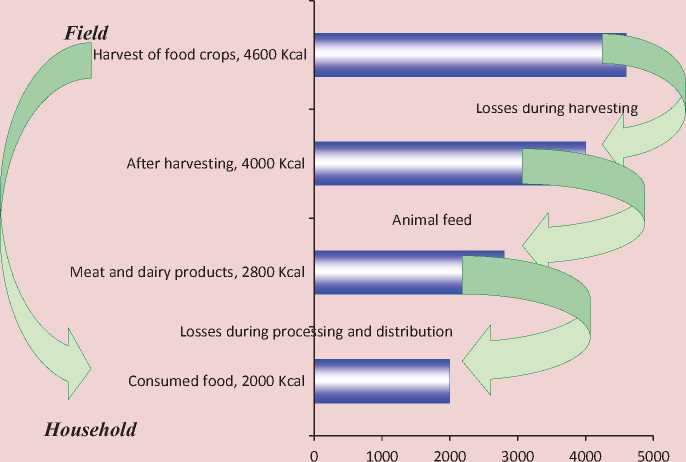
Note. Compiled by [7].
Packing. According to manufacturers, packing rather prevents losses than causes them (INCPEN, 2005); therefore, contrary to a popular opinion about the need to reduce the amount of packing materials there is an increase in their use (for example, in the UK 50% of all packing materials are used in food industry), which is followed by the diversification of the packing process in order to ensure its multi-functionality:
-
1. Standardization of processing and distribution. Nowadays packing is applied for standardization of production lines and simplification of logistics systems (for example, along with the primary packing secondary packing is used for easy transportation of goods by pallets).
-
2. Protection. Packing helps minimize damage to the transported goods and losses.
-
3. Safety and health of consumers. Packing enhances food safety and protects against biological and other types of pollution.
-
4. Shelf life. Packing extends shelf life and helps preserve the natural structure of products (for example, controlled packing atmosphere is used to improve the appearance of products).
-
5. Marketing, information and branding. Packing plays a key role in increasing the attractiveness of products, is used for communication with the consumer to transfer the nutrition information, time, the method of delivery, etc., (for example,
-
6. Speed of preparation. Packing can be used in order to reduce the time of cooking, especially when products can be just warmed up in the microwave (oven).
Distribution and exchange of food products . Nowadays the transportation of food amounts to more than 20% of the global road freight considered in tons of the transported products and 27% in t/km. The changes in distribution have helped diversify the range of food products in individual regional market segments due to the delivery of food that does not grow (or is not produced) in the area.
At the same time, at the present time the transportation distance, the method and some its stages are also significantly diversified and defined by the following features of the separate supply chain.
-
• On the one hand, the rise in the degree of food products processing and packing, as well as the demand for yearround supply of certain products instead of seasonal production have led to a greater number of links in the food supply chain and longer transportation distances. The products purchased by major retailers by means of global supply chains can be imported from far-located places (for example, meat and dairy products from New Zealand overcome about 18000 km to reach the European continent). In addition to the stage of transportation from the place (country) of origin to the place
of destination the large retail chains add a few more stages in the country of origin and/or destination to streamline logistics and inventory control, thus increasing the number of delivery stages and distance even for locally produced products. Some food supply chain are quite illogical at first glance (for example, the company producing sandwiches in Derbyshire has the plant located a few hundred meters from a shop of the large supermarket chain but it supplies its products to the retail delivery center of this chain located at the distance of more 100 km).
-
• On the other hand, the consumers who adhere to the principle “know your farmer, know your food” become more interested in locally produced products, which are sold at farms, nearest markets or directly delivered to ultimate consumers. It reduces the number of delivery stages and transportation distances (typically less than 50 km).
Thus, the study reveals the main trends in the global food system development at each stage of production, processing, packing, distribution, exchange and consumption of food, that is, at all stages of the food chain. It states that two opposite driving forces – consumers’ desire for readymade food with the deep level of processing and growing elite interest in a healthy diet – determine the development of productive forces in the agricultural complex in the direction of innovative search for various knowledge-intensive schemes of food production, processing and distribution that satisfy the consumers’ demand.
Current schemes are based on NBIC technologies (convergence of nano-, bio-, informational and cognitive technologies), comprising the in-depth research in biologically active substances, chemical composition, innovative manufacturing and nanotechnologies and molecular nutrition, studying the relationship between nutrition and human health.
Classification of main consumer types substantiates the demand for new types of product subcomplexes, among which the ecological forms of agriculture have a significant export potential and reserves for the Belarusian market development. So, the author’s proposals (EEU) are significant for the Republic of Belarus and for all existing and potential members of the Eurasian Economic Union.
Insufficient manufacture of certified environmentally friendly (organic) products on the territory of the EEU gives great possibilities for organic technologies to enter this segment of the world market, because the entry barriers are quite low, the competition is still relatively weak and the performance can be characterized by high rates of return.
In particular, the large capacity of the Russian food market with a deservedly high reputation of the Belarusian food products and the changed preferences of urban well-to-do population in the field of healthy nutrition and healthy lifestyle give grounds to speak about the potential success of diversification of agricultural production in Belarus in the sphere of organic technologies.
Taking into account the accumulated international experience, the government should focus on ecologization of the domestic food production complex, particularly on the implementation of two directions.
– First, for organic production, aimed at the internal market development, it is advisable to create a layer of small entrepreneurs. To achieve it the state should focus on informing the population about benefits of organic products, creating small farms that have extensive infrastructure of certification support, ensuring the products delivery to consumers. In addition, the development of small farms requires the allocation of regular government subsidies during the transformation period. At the same time, the problem of high financial and time costs can be addressed quite effectively if there is strong demand in the form of state order in the system of health-promoting, agro-and ecotourism, preschool upbringing and education (school meals), health care (feeding in the system of stationary institutions of health care), etc. However, a number of farms de facto manage their activity according to the basic principles of organic production that will minimize the amount of state preferences.
– Second , export-oriented organic production is managed by creation of a small number of large-scale organic farms. To form a competitive export sector the certification should comply with the international standards of potential markets, the network of strong players from existing traditional manufacturers should be created rapidly.
As a result of the conducted research we propose a “road map” for diversification of food production on the basis of organic (environmentally safe) agriculture. Its innovation and relevance lies in the scientific justification of the large-scale complex of economic, managerial and technological activities of the state level to develop a highly efficient organic sector of agricultural production:
-
1. Legislative and regulatory support for the development of organic production in order to ensure fair competition and proper functioning of the internal market for organic products, as well as maintain and justify consumers’ trust in products labeled as organic. This regulation should be aimed at ensuring the conditions under which this sector can develop simultaneously with the development of normal production and market by means of adoption of the law “On organic production” in Belarus and implementation of basic agro-ecological requirements and standards, consistent with the requirements and regulation of organic production in the EU.
-
2. Creation of the system of incentives and financial assistance for organic production on the basis of improvement of tax policy in terms of its application to the participants of organic production; optimization of state support for the development of rural areas and agriculture in compliance with the WTO; support for the implementation of regional investment projects aimed at applying the methods of organic production.
-
3. Scientific and advisory support for the development of organic production in the
-
4. Development of land relations and management forms by means of the improved system of state management of land resources, in particular in the zones of sanitary protection of water bodies; promotion of withdrawal of degraded, underproductive and polluted urban agricultural land from intensive use; provision of sustainable functioning of drainage systems and effective use of reclaimed lands; protection and reproduction of soil fertility, in particular, through the use of soil conservation technologies; formation of the ecological network as an effective mechanism to preservation landscape biodiversity.
-
5. Development of the production sphere through the state support for competitiveness of national organic agricultural products; implementation of scientifically-based systems for organic agricultural production management; state support for the production of organic fertilizers; state support for the production of biological means of plants and animals protection; introduction of energy-saving technologies.
-
6. Development of the agricultural market through the formation of the domestic market for organic certified products; enhancement of the marketing of organic products; promotion of export activities of the organic products manufacturers and expansion of the state support for external marketing; improvement of the agricultural and environmental image of the Republic of Belarus.
-
7. Enhancement of the safety and food quality through better consumer protection due to the improved state control over the quality and safety of organic food products, compliance of the national standards with international standards; implementation of the national system of certification;
form of state support and restructuring of agricultural science and education, teaching the rural population to conduct organic production, training specialists in the field of organic production according to the state order, expansion of research in organic production; creation of organic production subsystems in the unified information system of the agroindustrial complex; development of agricultural services to spread global and domestic best practices of organic production management.
marking organic agricultural products and food products; expansion of the production of organic food, particularly, of child nutrition; conservation of the in agricultural production zones that are free from the use of genetically modified organisms.
In conclusion it should be emphasized that in the Republic of Belarus the achievement of average parameters of the organic sector share (5–10%) with large volumes of food production and export in the absolute value can be a significant resource of currency receipts into the country’s economy. This potential increases significantly if the government seeks to achieve a 30% threshold of organic agriculture, set by the EU.
Список литературы Analysis and adoption of the experience of the global food system diversification in the Republic of Belarus
- Gusakov V.G. Voprosy rynochnogo razvitiya APK. Knigi 1-2 . Minsk, 2013.
- Il’ev F.V. Inbriding i geterozis v selektsii sel’skokhozyaistvennykh zhivotnykh . Kishinev: Kartya Moldovenyaska, 1987. 182 p.
- Inozemtsev V.L. Sovremennoe postindustrial’noe obshchestvo . Available at: http://ru.scribd.com/doc/12982954/. Accessed March 25, 2014
- Cato M.P. Zemledelie . Moscow, Leningrad, 1950, pp. 8, 9, 11, 12.
- Navstrechu “zelenoi” ekonomike: puti k ustoichivomu razvitiyu i iskoreneniyu bednosti: obobshchayushchii doklad dlya predstavitelei vlastnykh struktur . UNEP, 2011. 45 p.
- Nikitenko P.G., Solodovnikov S.Yu. Sotsial’no-ekonomicheskie sistemy Belarusi i Rossii: evolyutsiya i perspektivy . Minsk: Belaruskaya navuka, 2008.
- Agriculture & Rural Development. The World Bank. Available at: http://data.worldbank.org/topic/agriculture-and-rural-development. Accessed March 24, 2014
- Childhood Pesticide Poisoning, Information for Advocacy and Action. UNEP Chemicals (2004). Available at: http://www.chem.unep.ch/Publications/pdf/pestpoisoning.pdf. Accessed March 3, 2012.
- Executive Summary: Global Status of Commercialized Biotech/GM Crops: 2013 -ISAAA Brief 46-2013. Available at: http://www.bioportfolio.com/news/article/1819146/Executive-Summary-Global-Status-of-Commercialized-Biotech-GM-Crops-2013-ISAAA-Brief.html. Accessed March 24, 2014.
- Fourth Assessment Report of the Intergovernmental Panel on Climate Change. Working Group III Report: Mitigation of Climate Change. IPCC, 2007. 205 p.
- Organic Agriculture Worldwide: Key Results from the Survey on Organic Agriculture Worldwide 2010-2013. Available at: http://www.organic-world.net/yearbook-2012-presentations.html. Accessed March 4, 2012.
- Schaack D. News about the Organic Market in Germany 2011 Available at: http://www.organic-world.net/fileadmin/documents/yearbook/2012/2012-02-16/schaack-120216_Bio_UmsatzDE_engl.pdf. Accessed March 4, 2012.
- The Environmental Food Crisis. UNEP, 2009. Available at: http://www.grida.no/_res/site/file/publications/FoodCrisis_lores.pdf. Accessed August 25, 2014.
- The Statistics Division of the FAO. Available at:: http://faostat.fao.org/site/291/default.aspx. Accessed March 4, 2012.

